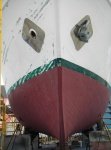I used a set of ten foot spruce oars, commercially produced, and conventional oarlocks set on the coamings of a 20.5 ft inboard Bartender with some success.
As others mention, you need long oars to get the blades in the water. I rowed from a standing position jusr forward of the CG, or sitting on the engine box, midships. Two of those events were unplanned and unanticipated. In each case, the oars moved the vessel along at a ripping 1.5 knots, in light air. The boat was very maneuverable and easily turned. But, the windage of the boat, considerably less than a 22 ft C-Dory, would have easily overpowered the oars. They would be useful in altering its wind-driven course, but unable to row to windward in a headwind of more than about 5 knots.
The oars would help to reach protected waters downwind of an engine failure, and would allow you to select which end of the boat you want to beach. My unplanned rowing events in one case got the boat from an open marina over to a float, just 30 yards away when I wrapped the bow line in the prop, and in another case extracted me from a very muddy lee shoreline when I did not want to run the wngine for fear of striking rocks embedded in the mud. Without the oars, in both events, I would have been up that proverbial creek.
Here are a couple shots of the layout, for the curious.
Rowing sitting on the engine box:
http://www.pbase.com/bartenderdave/image/92098087
Oarlock located on coaming:
http://www.pbase.com/bartenderdave/image/92098085
Should not be too big a stretch to do something similar in a 22 C-Dory. A 25? Not likely to work well, owing to the greater beam and greater reach to the water. A 16 would be easy.


